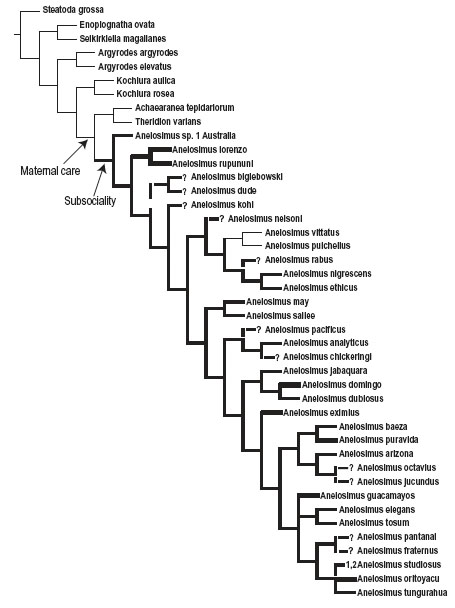Social Spiders
Austen Brown and Jenny Eng
Phylogeny
Phylogeny is the organization of species based on their evolutionary relatedness. Researchers have compiled a phylogeny of social spiders inferred from morphological and genetic similarities.
Frequency and Distribution of Sociality
Permanent sociality is only found in 20-25 species out of the nearly 39,000 identified spider species (12). Sociality has arisen in eight different spider families, a surprisingly varied phylogenic distribution considering its rarity. Most of these families contain just 1-4 species of social spiders, the exception being the cobweb spider family Theridiidae, which contains 12 species (12). Focusing on Theridiidae elucidates the phylogenetic trends inherent to spider sociality.

Phylogenetic tree of the genus Anelosimus (of the Theridiidae family). Bold branches are fully social species, medium branches are subsocial species and narrow branches are solitary species. Image taken from reference 1.
Theridiidae: a family focus
Maternal Care
The social Theridiids are clustered on a far-flung branch of the family tree, suggesting a novel adaptation in this branch was a necessary catalyst for spider sociality (10). One hypothesis posits a temporal extension of maternal care as the ancestral behavior for sociality. According to this maternal care hypothesis, juvenile characteristics such as web sharing, cooperation and peer-peer and generational tolerance were extended into adulthood by delay of dispersal and prolonged maternal care (9). Agnarsson claims that while maternal care is a necessary prerequisite to sociality, it does not wholly account for the behavior because it occurs in many solitary species.
Web Building
The further observation that all social spiders are web builders is significant because less than half of all spider species make webs (10). Krafft compares webs to the social pheromones of social insects, because vibrations traveling along the webs allow for communication at a distance (10). However, Rypstra found that during hunting, Anelosimus does not send vibrational signals (11).
Conspecific Tolerance
The social Theridiidae branch consists of three genus: Anelosimus, Theridion and Achaearanea. A so-called “sister clade” to this group, derived from the same ancestral stock, is Argyrodes, genus of the kleptoparasitic spiders (10). Kleptoparasites steal their food from other species—these spiders feed off the catch of other spiders. Most spider kleptoparasites are solitary, but interestingly, individuals of some species can aggregate on the same host web, showing high levels of interspecies tolerance (10). This suggests that a key ancestral adaptation increased such conspecific tolerance.
Effects of Inbreeding on Phylogeny
Within the Theridiidae, sociality has evolved at least 8 separate times (12). Each origin, however, only results in a couple species. Every evolution of sociality is accompanied by a shift from outbred, panmitic populations, to inbred, subdivided populations with skewed sex ratios (8). Whether inbreeding is a cause or effect of sociality is undetermined, but the costs of this inbreeding explain the lack of radiation of social spider species (8). Inbreeding’s cost of decreased diversity results in genetically impoverished species without the genetic potential to radiate into new niches. All surviving social spider species have a relatively recent origin of 20-40 million years ago, possibly an artifact of accelerated extinction rates due to inbreeding (9).
Agnarsson explains these phylogenetic patterns in terms of short and long term evolutionary pressures. In the short term, group living conveys a considerable ecological benefit, giving access to larger prey, supplying protection, and turning peers from enemies to comrades (13). Inbreeding allows families to produce more females than males because only a few sons are needed to fertilize all the daughters; this is apparent in the characteristic skewed sex ratios (8). These benefits explain the numerous origins of sociality; it is a repeated convergent evolution. The long term costs of inbreeding, however-- low genetic variance and an unstable population structure-- result in few speciation events and steep extinction rates (13). The abbreviated clades of social spiders clearly reflect these long-term evolutionary drawbacks.